Open and Accurate Air Quality Monitors
We design professional, accurate and long-lasting air quality monitors that are open-source and open-hardware so that you have full control on how you want to use the monitor.
Learn MoreBosch’s new BMV080 PM sensor is causing quite a stir in the air quality world and when you see its minuscule 4.4mm x 3mm x 20mm size, it’s easy to understand why. This sensor is fundamentally different from anything we’ve seen before, measuring particles up to 35cm in front of the device rather than within an internal chamber. But does this innovative approach actually work in real-world conditions?
We’ve been putting the BMV080 through an extensive range of testing — from temperature extremes and strong vibrations to rain simulation and obstruction challenges. We’ve also put it in direct comparison against our Palas Fidas 200 reference monitor. Some results were exactly what we anticipated, while others genuinely surprised us. What’s clear is that this sensor’s unique outward-facing design creates both exciting possibilities and some notable limitations that anyone considering this technology should understand.
Before we dive into the details about this tiny sensor, let me quickly explain what PM sensors actually do. PM stands for particulate matter, which are the tiny particles floating around in the air that we can’t see with our naked eyes. These sensors measure concentrations of particles like PM2.5 (particles smaller than 2.5 micrometers) and PM10 (particles smaller than 10 micrometers), which include things like dust, pollen, smoke, and other pollutants. Many consumer air quality monitors use these sensors to tell you whether the air you’re breathing is clean or if you are breathing unhealthy air.
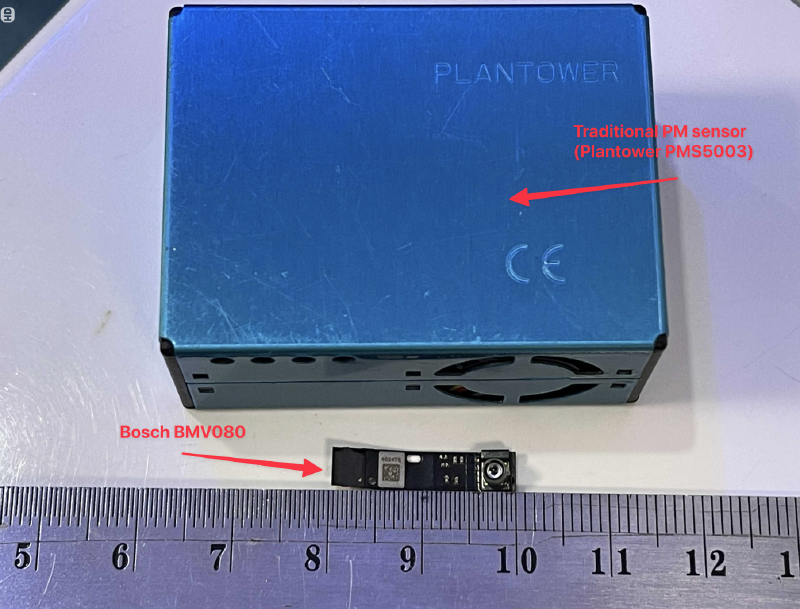
There are a few things that make the BMV080 unique beyond its tiny size, which means it could work in applications where traditional PM sensors simply won’t fit.
To achieve this smaller size, Bosch had to completely rethink how current particle sensors work. Where most consumer-grade PM sensors use a laser and photodiode setup to measure particles within an enclosed chamber, the BMV080 takes a different approach. It uses integrated lasers with tiny diodes built in and instead of firing a laser across an internal chamber (which requires a minimum distance between components), the BMV080 aims its laser outwards and measures particles in the surrounding air by measuring how much light is reflected back towards the sensor.
This means the sensor is actually measuring particles in a zone up to 35cm in front of the device, not particles inside the chamber (like most current PM sensors).
This approach also eliminates the need for a fan to ensure consistent airflow. While we can’t speak to the longevity yet (we simply haven’t had it long enough), Bosch claims this design prevents dust buildup, potentially giving the sensor a longer lifespan than traditional designs.
Before conducting accuracy testing against our reference monitor (we will show those results soon!), we wanted to understand what this revolutionary new form factor actually means in practice. The BMV080’s unique design creates entirely different benefits and limitations compared to traditional PM sensors.
Our focus for this first round of testing was specifically on form factor implications. How does this external measurement approach behave in real-world conditions? What new possibilities does it create, and what constraints does it impose?
If you’re interested in how the device performs compared to our reference monitor, you can find these results below.
Note: In the test footage, the sensor is attached to our development/testing board, so it looks bulkier than it actually is. You can see how tiny the sensor itself is in the image above.
Every time we turned the sensor on, we noticed a considerable delay before it would start reporting accurately. When first powered up, the readings would spike dramatically, taking 45-60 seconds to normalize. For context, Plantower sensors also need about 20 seconds to warm up, but the BMV080’s warm-up period is significantly longer with a much more dramatic spike.
This won’t be an issue if the sensor can stay constantly powered, but it makes the device less ideal for applications requiring frequent on/off cycles. Current portable devices using sensors like the Plantower or Sensirion SPS30 only turn on intermittently to save battery life. Since the BMV080 likely uses far less power (something we still need to test), it might actually be able to stay on continuously in situations where other sensors would cycle on and off negating this downside. Of course, for static monitors that have a continuous power supply, this won’t be an issue.
Unlike traditional PM sensors that contain both laser and detector within a single chamber, the BMV080 fires its laser into open air. This creates an obvious limitation - you need a clear line of sight for at least 35cm in front of the sensor (Bosch’s recommendation).
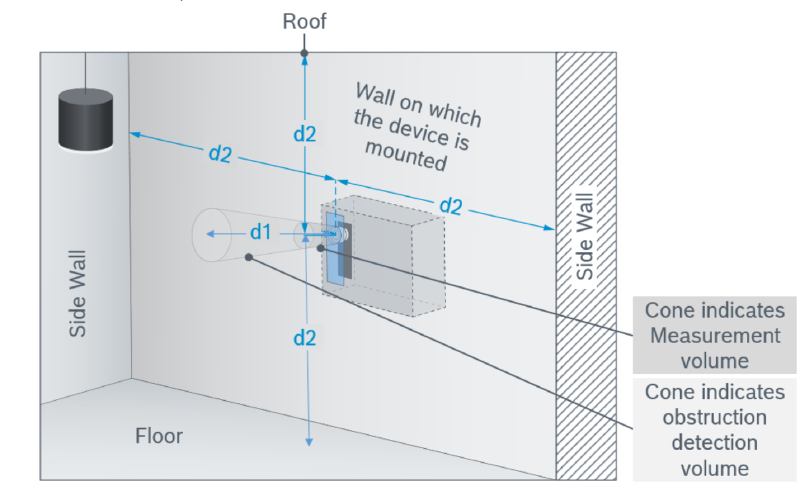
Image from BMV080 Integration Manual.
We found their 35cm estimate to be pretty accurate. If anything large passes through that space (such as a hand) the readings skyrocket immediately.
Bosch does provide an “obstruction detection” mode, but it has limited usefulness. Instead of alerting us to obstructions, it just kept repeating the last reading from before the obstruction was detected. So if the sensor measured 9 µg/m³ of PM2.5 and then detected an obstruction, it would continue showing 9 µg/m³ until the obstruction cleared. It is worth noting that we believe this may be a bug, as the BMV080 manual does mention a ‘warning’ being sent if an obstruction is detected.
Since this sensor could be excellent for portable applications, we tested how it handles movement. The results were surprisingly good - consistent readings even while the sensor was being shaken around in the air.
However, when we flicked the device hard (simulating significant vibrations), readings shot up immediately and took over 30 seconds to normalize. While flicking a sensor is pretty extreme, this suggests the device might struggle with serious vibrations. We’ll need to test this more thoroughly.
While this might seem like quite an unlikely situation, we wanted to do this test because the BMV080 could be the ideal PM sensor for portable monitors. As someone who usually has an Atmotube attached to my backpack, I can say that it certainly gets exposed to quite a few bumps throughout the day.
Since the device emits a laser outward, we wondered if direct bright light - like sunlight - would interfere with readings. We shone a bright light directly at the sensor, and it performed well. The sensor should provide accurate readings even in bright conditions.
We checked Bosch’s documentation to see if a specific wavelength was mentioned, but we were unable to find any further information.
We used a hair dryer to heat the device while monitoring PM readings. The AirGradient monitor in the background (about 30cm away) recorded a 5°C increase, but the Bosch sensor likely reached much higher (and quite extreme) temperatures.
Even with this temperature increase, the BMV080 recorded virtually no change in particle concentration. Any minor changes we saw were probably from particles blown past the sensor by the hair dryer, not temperature effects.
Looking at Bosch’s specifications this makes sense. They state that temperature changes don’t affect precision (consistency), but that accuracy can degrade at temperatures away from the 25°C calibration point that these sensors are tested at. As per their documentation, at 35°C, additional measurement errors of around ±11 µg/m³ are expected, which our simple test setup wouldn’t have detected. This is something we will have to test against our reference monitor.
The sensor isn’t waterproof, so we didn’t put it in water. With that said, we were curious whether water falling in front of the sensor (within that 35cm detection zone) would affect readings. Again, this could be important if this sensor is to be used in a portable or outdoor monitor.
We simulated rain falling in front of the sensor, and it performed excellently. There was no reaction to the falling water at all.
We exposed the sensor to direct wind from a handheld fan. While there were some reading changes, none were significant, and they were likely caused by particles being blown around rather than the wind itself affecting the sensor operation. The sensor maintained stable performance.
For our final form-factor test, we placed a glass screen protector over the sensor to see if it could measure through the covering. This was particularly interesting because good performance here could indicate waterproof enclosures are possible with this sensor.
There was an initial spike when we placed the cover, but readings quickly stabilized afterward. While we haven’t tested the accuracy of readings through glass or clear plastic yet, the device clearly continued functioning.
This has some exciting implications for air quality monitor applications, and we’re eager to test it further against our reference sensor. On that note, if you’re interested in the accuracy of the Bosch BMV080, read on!
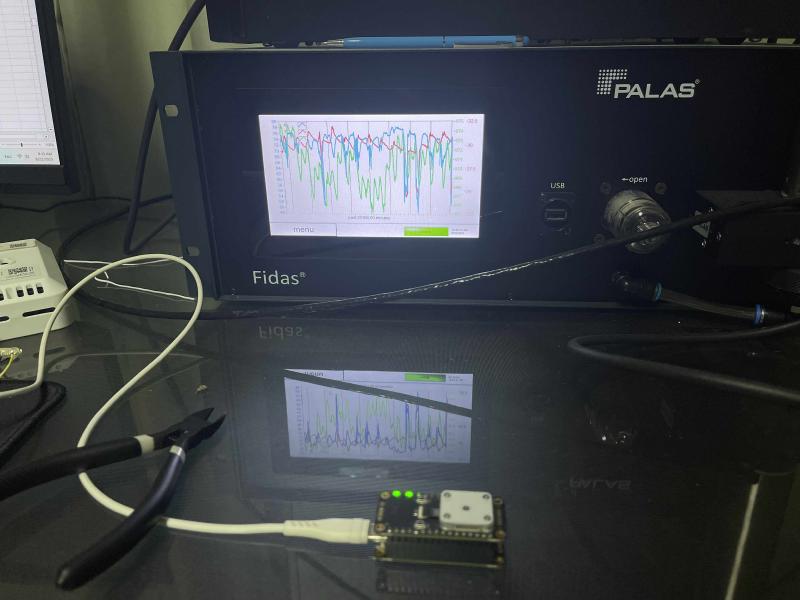
To better understand how the Bosch BMV080 performs, we decided to compare it against a reference-grade instrument. These devices typically cost tens of thousands of dollars and are considered the gold standard for measuring particle concentrations. Because of their accuracy, they are one of the few reliable baselines available when evaluating low-cost air quality sensors. While different models of reference instruments exist, all must meet strict regulations and are routinely used by universities, research institutes, and government agencies worldwide.
At AirGradient, every fully assembled device is tested in our test chamber before it ships out. This chamber is equipped with a Palas Fidas 200 – an EU-certified reference instrument that meets regulatory monitoring standards. Using the Palas as our benchmark allows us to validate sensor accuracy under controlled and repeatable conditions, something that sets us apart from many other manufacturers.
The chamber itself is air-tight, with adjustable intake and exhaust controls that let us raise or lower particle concentrations in a precise way. To generate particles, we burn incense sticks. Incense smoke provides a convenient source of aerosols, although the particles it produces are often on the smaller side. This is important to note because the Palas Fidas can detect particles as small as 0.18 µm, while the Bosch BMV080 has a lower detection limit of around 0.5 µm. As a result, a portion of the incense particles will register on the Palas but remain invisible to the Bosch. When we take a look at the results, this will help explain why the Palas tends to report consistently higher concentrations. It’s also worth noting that this limitation is not unique to the BMV080 — it applies broadly to most low-cost optical particle sensors.
| Monitor | Minimum Detected Particle Size |
|---|---|
| Palas Fidas 200 | 0.18 µm |
| Bosch BMV080 | 0.5 µm |
We put the Bosch BMV080 through two separate chamber procedures. The first was our standard accuracy test – the same one that every pre-assembled AirGradient monitor undergoes before shipping. In this test, we gradually increase PM2.5 concentrations, hold them at a series of plateaus, push them up to a peak of about 60 µg/m³, and then let them fall again. The full run lasts around three hours.
The second test was designed specifically for the Bosch BMV080. In this case, we raised particle concentrations much higher, up to around 120 µg/m³, and then allowed them to naturally decline over the course of about three hours. The goal was to see how well the Bosch maintained accuracy at elevated levels, beyond the range we normally test for.
It’s important to keep in mind that these are both preliminary tests. Comprehensive evaluations typically span months, generating hundreds of thousands (or even millions) of data points across varied real-world environments. Our chamber run provides a useful first impression, but it is only one piece of the bigger picture when it comes to understanding sensor performance.
Below is a time-series graph showing the PM2.5 concentrations measured by the Palas Fidas (red) and the Bosch BMV080 (green) over the course of our standard test procedure. Time-series plots are particularly useful in this context because they allow us to see how closely the Bosch sensor tracks the Palas as concentrations rise and fall. This graph shows us not just how accurate the sensor is, but also how responsive it is to changes in the environment.
As can be seen straight away, the Bosch sensor followed the Palas closely, reproducing the overall shape and timing of the red concentration line. However, it consistently underreported the PM2.5 concentration. As mentioned in the introduction, this is something we expected due to its higher minimum detection size (0.5 µm vs. 0.18 µm for the Palas). The difference also becomes more pronounced at higher concentrations, suggesting that the Bosch underestimates more as levels increase.
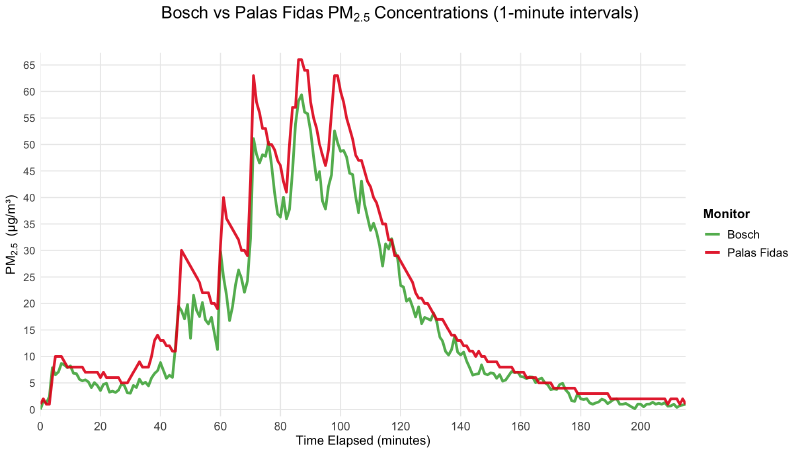
When plotted at 1-minute intervals, the Bosch data shows noticeably more short-term variation, or “noise,” compared to the Palas. To help smooth out this variability, I also averaged both data sets into 5-minute intervals. Doing so reduced the noise and made the overall agreement between the Bosch and Palas easier to see.
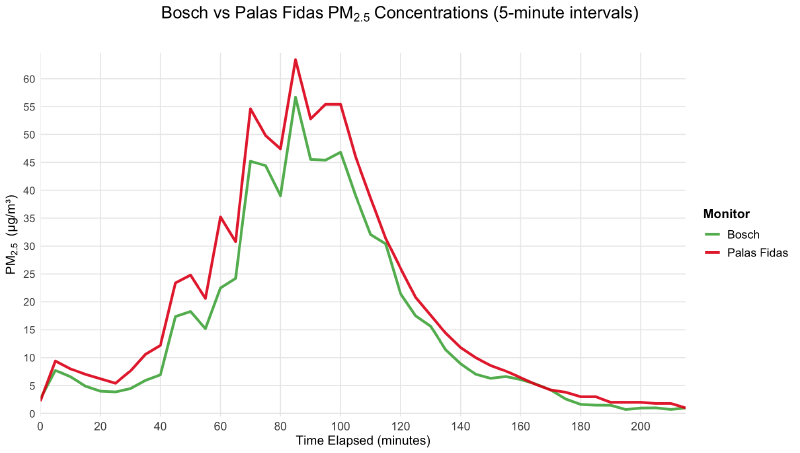
With 5-minute averaging, the trend becomes clearer: the Bosch still underreports compared to the Palas, but the curve shapes remain very similar. This indicates that while the Bosch BMV080 may not provide completely precise absolute concentrations, it is effective at tracking relative changes in PM2.5 levels over time - especially at lower concentrations.
Next, I wanted to take a deeper look at how the Bosch sensor performs in relation to the Palas. To do this, I created two scatter plots. These plots are a way to compare two sets of measurements directly against each other. In this case, each point represents one time interval, with the Palas Fidas measurement on the x-axis and the Bosch BMV080 measurement on the y-axis. If both instruments agreed perfectly, every point would fall exactly on the red dashed 1:1 line. The further a point is from this line, the larger the disagreement between the two devices.
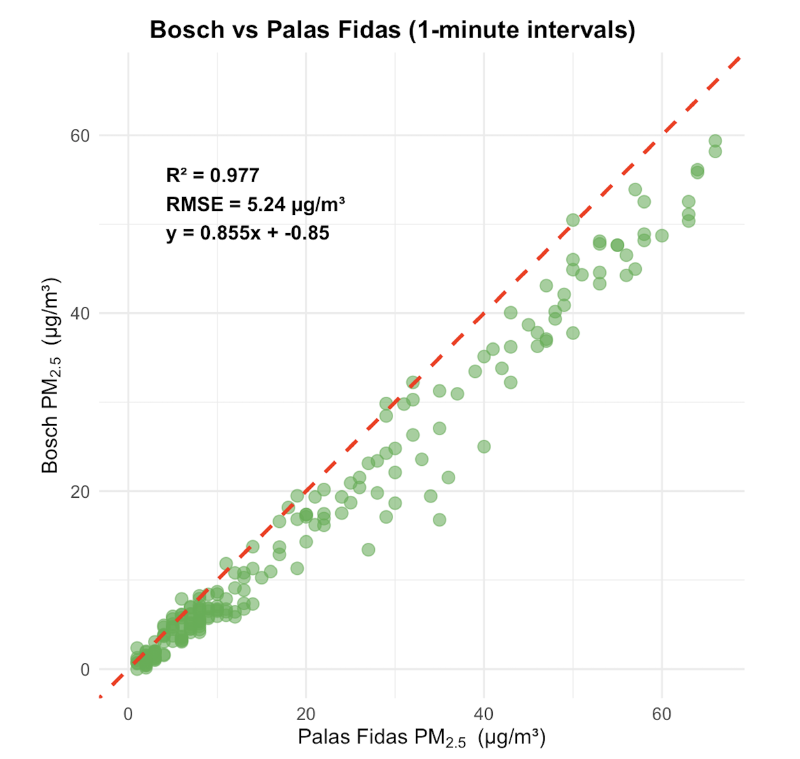
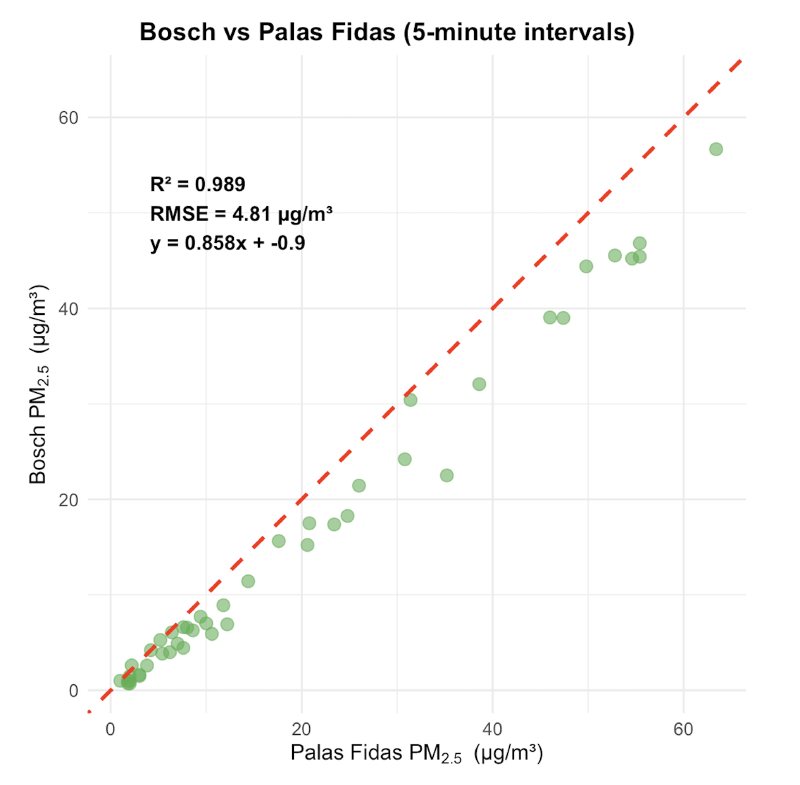
One way to quantify this agreement is with the coefficient of determination (R²). R² ranges from 0 to 1, where 1 indicates a perfect correlation. In both the 1-minute and 5-minute datasets, the Bosch achieved an R² above 0.97, showing a very high correlation with the Palas Fidas. As expected, the 5-minute averaging improved the correlation, since it smoothed out short-term fluctuations and helped to account for noise.
Another useful metric is the root mean squared error (RMSE). RMSE tells us the average size of the errors between the Bosch and Palas, expressed in the same units (µg/m³). Here, the 5-minute data had an RMSE of about 4.8 µg/m³. Lower RMSE values mean the two instruments agree more closely, and, as expected, this value was smaller for the five-minute averaged data.
Also consistent with what I saw in the time-series plots, the Bosch BMV080 systematically underestimates the Palas readings. The fact that this underestimation appears to be fairly systematic suggests that accuracy could be improved with a correction factor or calibration curve. It’s also worth remembering that this is likely caused by the fact that the Palas sees a wider range of particle sizes.
Overall, this is excellent performance for a low-cost sensor. I was surprised to see the Bosch BMV080 perform this well. In fact, when compared to the Plantower sensors we use in AirGradient monitors, the Bosch consistently achieved a slightly higher R² (better correlation with the Palas), but at the cost of a higher RMSE (indicating more noise).
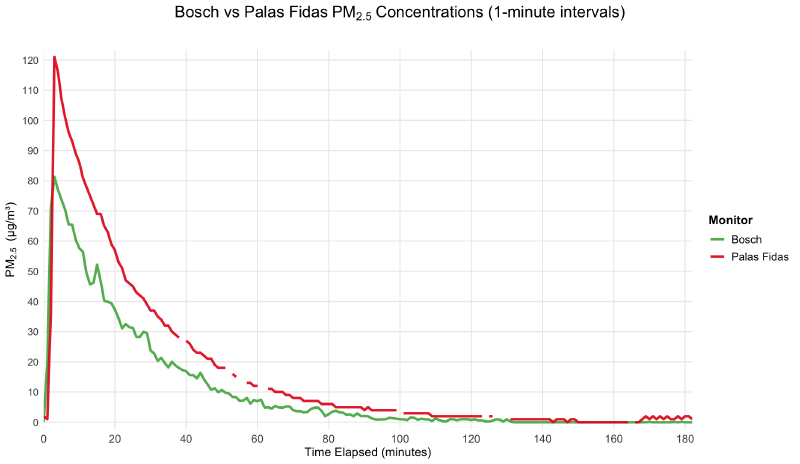
To further test the Bosch sensor, we ran a second chamber experiment. In this run, PM2.5 concentrations were quickly raised to around 120 µg/m³ and then allowed to naturally settle over about three hours. While we had a few missing data points from the Palas, the overall trend was still very clear. This test highlights that as particle concentrations increase, accuracy declines as the Bosch BMV080 underreports more strongly at these higher levels. The time-series graph below (using 5-minute averages) shows this clearly, as smoothing helps reduce noise but doesn’t eliminate the underestimation.
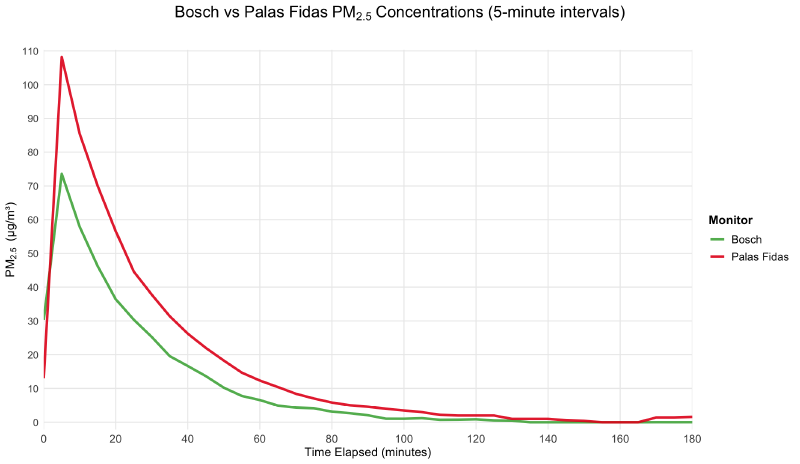
Looking at the scatterplots, both the R² and RMSE values were worse than in the first test. This is expected, since the Bosch BMV080 struggles more at higher concentrations. At lower levels, it tracks the Palas closely, but as concentrations rise, it drifts further from the 1:1 line.
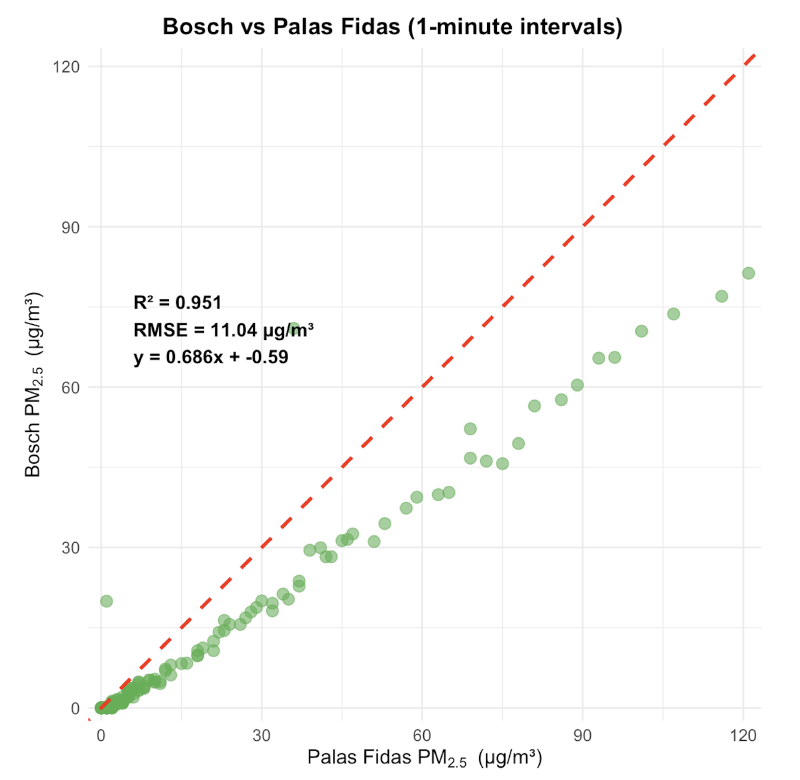
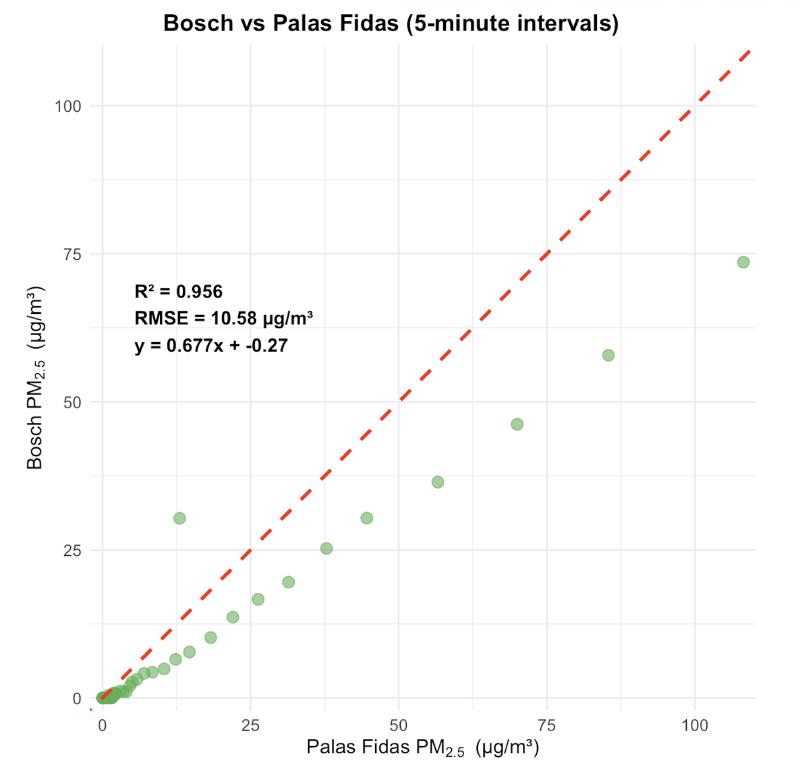
Overall, the second test confirmed that the Bosch BMV080 performs very well at low to moderate particle concentrations, but its accuracy declines significantly once particle concentrations climb higher. The underestimation becomes more pronounced and the scatter increases, showing a weaker correlation and higher error compared to the first test.
While smoothing helps reduce some of the noise, it cannot fully correct the systematic bias. In practical terms, this means the BMV080 should be accurate for typical indoor and outdoor air quality levels but should be used with caution in environments with very high concentrations. However, it’s important to emphasise again that this was using incense smoke, and Bosch calibrated/tested these sensors with Arizona road dust.
I came away from these tests genuinely impressed with how well the Bosch BMV080 performed in our chamber. For such a small and still relatively low-cost sensor, it tracked the Palas reference surprisingly closely, especially at lower concentrations. The future looks bright for this new generation of particle sensors.
That said, there are still some practical limitations that affect how it can be used today. The requirement for 35 cm of unobstructed clearance in front of the sensor is a major constraint. It also has a noticeably long initialization time, and we found that vibrations can throw it off significantly. We’re not entirely sure what’s happening behind the scenes, but the fact that it takes so long to initialize (and to recover after a vibration) suggests there is a lot of internal processing going on.
This first round of testing gave us some great insights, but it’s only the beginning. We want to keep putting the BMV080 through its paces, and the next step will be outdoor ambient air testing to see how it holds up in real-world conditions.
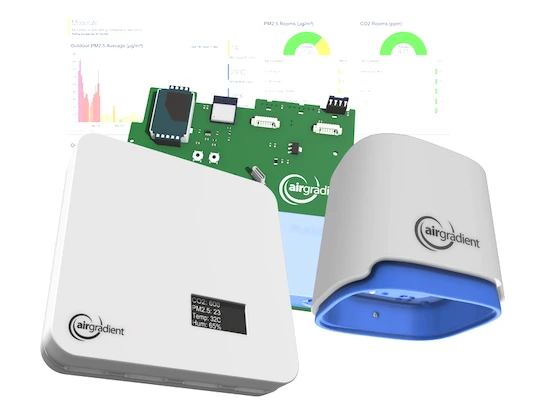
We design professional, accurate and long-lasting air quality monitors that are open-source and open-hardware so that you have full control on how you want to use the monitor.
Learn MoreCurious about upcoming webinars, company updates, and the latest air quality trends? Sign up for our weekly newsletter and get the inside scoop delivered straight to your inbox.
Join our Newsletter